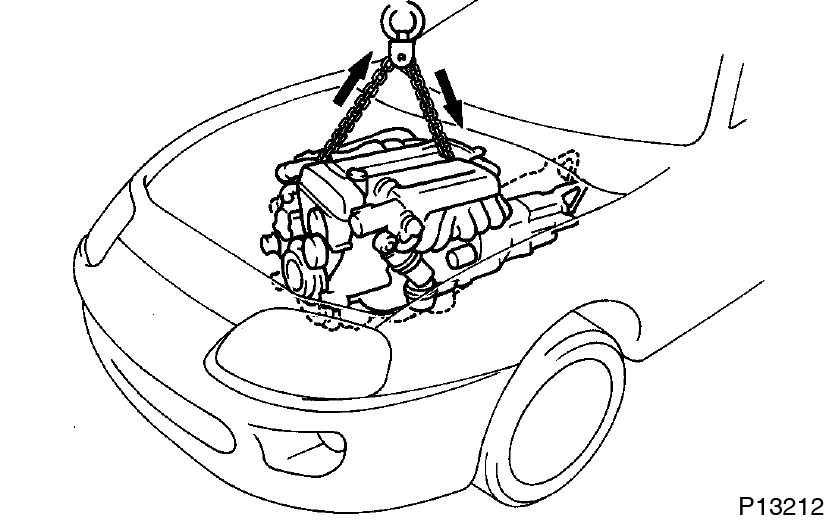- Introduction
- Maintenance
- Preparation
- Service specifications
- Diagnostics
- 2JZ-GE Engine
- 2JZ-GTE Engine
- 2JZ-GTE Turbocharging
- 2JZ-GE Emission control
- 2JZ-GTE Emission control
- 2JZ-GE SFI
- 2JZ-GTE SFI
- Cooling
- Lubrication
- Ignition system 2JZ-GE
- Ignition system 2JZ-GTE
- Starting system
- Charging system
- Clutch
- W58 manual transmission
- V160 manual transmission
- A340E 2JZ-GE automatic transmission
- A340E 2JZ-GTE automatic transmission
- Propeller shaft
- Suspension and axle
- Brake system
- Steering
- Supplemental restraint system
- Body electrical system
- Body
- Air conditioning system
- Remove hood
- Remove radiator assembly (See page CO-22 )
- Drain engine oil
- Drain fuel from fuel tank
- Disconnect control cables from throttle body
Disconnect these cables:- Accelerator cable
- Cruise control actuator cable
- Remove air cleaner, MAF meter and intake air connector pipe assembly
- Disconnect the high-tension cord from the ignition coil.
- Disconnect the high-tension cord from the clamp on the air cleaner.
- Disconnect the MAF meter connector.
- Disconnect the these hoses:
- PS air hose from No.4 timing belt cover
- PCV hose from no.2 cylinder head cover
- Loosen the hose clamp bolt holding the intake air connector pipe to the throttle body.
- Remove the 3 bolts, air cleaner, MAF meter and intake air connector pipe assembly.
- Remove drive belt, fan, fluid coupling assembly and water pump pulley (See page CO-7 )
- Remove charcoal canister
- Disconnect heater water hoses
- Disconnect brake booster vacuum hose
- Disconnect EVAP hose
- Disconnect wires and connectors
- Disconnect the noise filter connector.
- Disconnect the ignition coil connector.
- Disconnect the engine wire from the wire clamp.
- Remove the rubber cap and nut, and disconnect the generator wire.
- Disconnect these connectors:

- Connector from engine room main wire
- igniter connector
- Theft deterrent horn connector
- Disconnect the engine wire from the 2 wire clamps.
- Disconnect the wire clamp and PS solenoid valve connector.
- Remove the bolt, and disconnect the ground strap from the cylinder block.

- Remove the rubber cap and nut, and disconnect the starter wire.
- Disconnect fuel hoses
- Remove the union bolt and 2 gaskets, and disconnect the fuel inlet hose.
- Put a suitable container or shop rag under the fuel pipe support.
- Slowly loosen the union bolt.

- Suspend the hose union end upward.
- Disconnect the fuel return hose from the oil dipstick guide.

- Disconnect the fuel return hose from the fuel return hose.
Plug the hose end.
- Remove the union bolt and 2 gaskets, and disconnect the fuel inlet hose.
- Disconnect PS pump without disconnecting hoses
- Remove the 3 bolts, plate washer and pump front bracket.

- Disconnect these hoses:

- Air hose from No.4 timing belt cover
- Air hose from air intake chamber
- Disconnect the vane pump from the pump bracket. Put aside the pump housing, and suspend it.
- Remove the 2 bolts and pump rear stay.
- Remove the 2 bolts and pump bracket.
- Remove the 3 bolts, plate washer and pump front bracket.
- Disconnect PS pressure feed hose from engine
Remove the 2 clamp bolts and disconnect the pressure feed hose.
- Disconnect a/c compressor without disconnecting hoses
- Remove the 2 bolts.

- Disconnect the compressor connector.

- Remove the bolt and nut.
- Using a torx socket (E10), remove the stud bolt, and disconnect the compressor from the engine. Put aside the compressor, and suspend it securely.
- Remove the 2 bolts.
- Disconnect engine wire from cowl panel
- Remove the bolt, and disconnect the ground strap.

- Remove the 2 bolts, and disconnect the engine wire protector.
- Remove the 2 bolts holding the engine wire retainer to the cowl panel.

- Remove the bolt, and disconnect the ground strap.
- Disconnect engine wire from cabin
- Remove the scuff plate.

- Take out the front side of the floor carpet.
- Remove the 2 nuts and ECM protector.
- Remove the nut, and disconnect the ECM from the floor panel.
- Disconnect the 2 connectors from the ECM.

- Disconnect the connector from the TRAC ECU.
- Disconnect the connector from the instrument panel wire.
- Disconnect the 2 connectors from the connector cassette.
- Pull out the engine wire from the cabin.
- Remove the scuff plate.
- M/T:
Remove upper console panel, shift lever boots and holding bolts- Remove the shift lever knob.

- Using a screwdriver, pry out the upper console panel.
- Remove the 4 bolts holding the lever boot to the transmission cover.

- Remove the shift & select lever boots.
- Remove the 4 bolts holding the shift lever to the shift lever retainer.
- Remove the shift lever knob.
- M/T:
Disconnect clutch release cylinder and ground strap from transmission- Remove the 2 bolts, and disconnect clutch release cylinder.

- Remove the bolt, and disconnect ground strap.
- Remove the 2 bolts, and disconnect clutch release cylinder.
- Remove No.2 exhaust pipe assembly
- Remove the 2 bolts and nuts holding the No.2 front exhaust pipe to the front exhaust pipe.

- Remove the 2 bolts and pipe support bracket.
- Remove the gasket, and disconnect the front exhaust pipe.
- Remove the 4 nuts, No.2 front exhaust pipe and 2 gasket.

- Remove the 2 bolts and nuts holding the No.2 front exhaust pipe to the front exhaust pipe.
- Remove exhaust pipe heat insulator
- Remove propeller shaft (See page PR-4)
- A/T:
Disconnect transmission control rod
Remove the nut, and disconnect the control rod from the shift lever.
- M/T:
Remove transmission shift lever- Remove the bolt and nut.
- Remove the transmission shift lever, inside of vehicle.

- Place jack under transmission Be sure to put a wooden block between the jack and the transmission oil pan to prevent damage (A/T).
- Remove rear support member
- Remove the 4 nuts holding the member to the engine rear mounting insulator.
- Remove the 4 bolts and rear support member.

- Remove engine and transmission assembly from vehicle
- Attach the engine hoist chain to the 2 engine hangers.

- Remove the 2 nuts holding the engine front mounting insulators to the front suspension crossmember.

- Lift the engine out of the vehicle slowly and carefully.
 Remove the engine and transmission assembly carefully without damaging the shift lever retainer (M/T), A/C compressor or PS solenoid valve.
Remove the engine and transmission assembly carefully without damaging the shift lever retainer (M/T), A/C compressor or PS solenoid valve. - Make sure the engine is clear of all wiring, hoses and cables.
- Place the engine and transmission assembly onto the stand.
- Attach the engine hoist chain to the 2 engine hangers.
- A/T:
Remove oil dipstick and guide for transmission- Remove the bolt.
- Pull out the dipstick and guide from the transmission.
- Remove the O-ring from the dipstick guide.
- Disconnect engine wire from transmission
- Disconnect the connectors.
- Disconnect the wire clamps from the brackets.
- Remove starter
- Disconnect the starter connector.
- Remove the 2 bolts, wire bracket and starter.
- Disconnect throttle cable
- Disconnect the throttle cable from the throttle body.
- Disconnect the throttle cable from the cable bracket on the cylinder head.
- A/T:
Remove oil cooler tubes for transmission- Remove the 2 hose clamp bolts and tube clamp bolt.
- Loosen the 2 union nuts, and remove the oil cooler tubes.
- A/T:
Remove torque converter clutch mounting bolts- Remove the hole plug.
- Turn the crankshaft to gain access to each bolt. Remove the 6 bolts.

- Separate engine and transmission
Remove the 6 bolts and transmission. The ”17” is 17 mm head bolt, and ”14” is 14 mm head bolt.
The ”17” is 17 mm head bolt, and ”14” is 14 mm head bolt. - M/T:
Remove clutch cover and disc
- Place matchmarks on the flywheel and clutch cover.
- Loosen each bolt one turn at a time until spring tension is released.
- Remove the bolts, and pull off the clutch cover with the clutch disc.
Do not drop the clutch disc.




